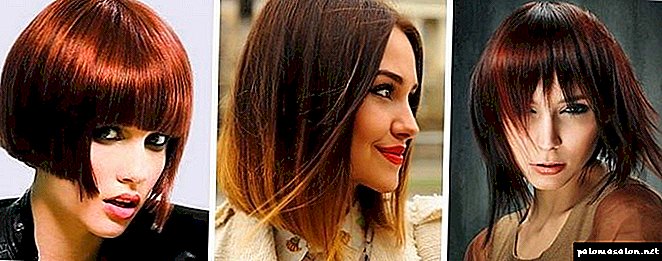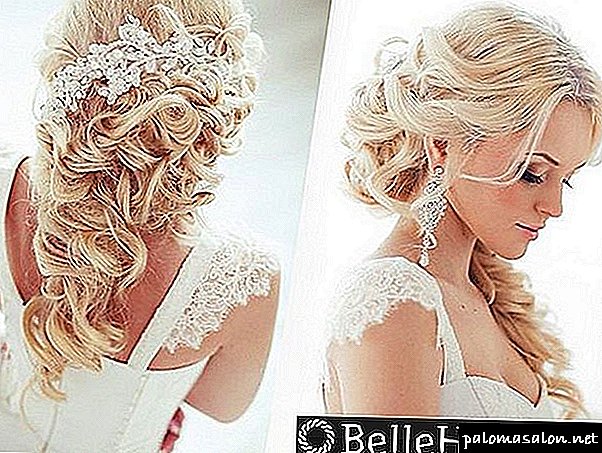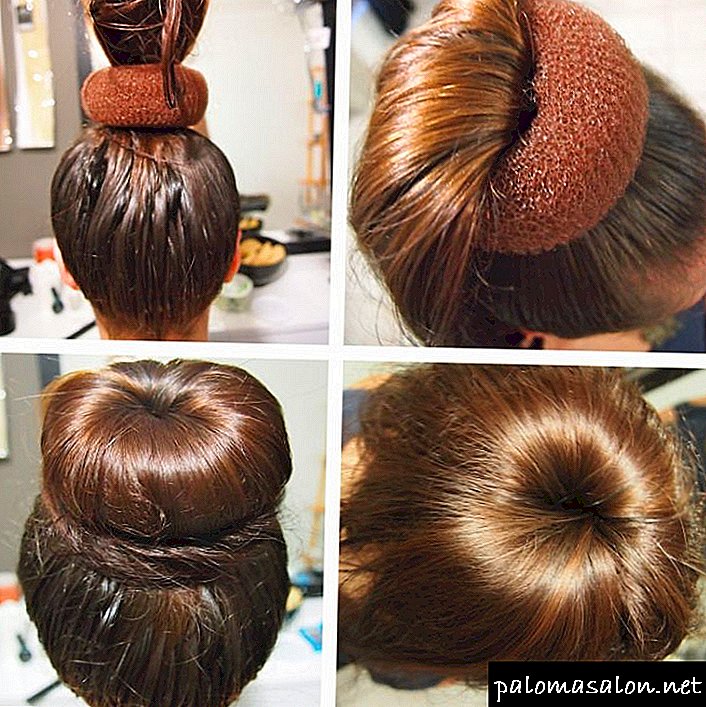
Not everyone can manage to have long and thick curls from nature, therefore many are looking for alternative ways. One of them is hair tress, which helps to create the necessary hairstyle quickly and safely. What is hair extensions on tresses and how comfortable is it?
Tresses are bunches of hairs connected by one thin fabric strip. They are made by hand and on special equipment. The length of the strands 10-100 cm.
Types of tress
Tress are:
- artificial: made of synthetic materials. Low quality, inexpensive (about 1 thousand rubles for a pack of 10 strands),
- natural: created from human donor curls. High quality and expensive (about 6,800 rubles).
Features of the procedure
In comparison with other types, hair extension on tresses is the most gentle method. It does not use chemical compounds (except for bonding), thermal effects and other manipulations that could harm the native hair.
Price depends on the volume and origin of the material. European strands 40 cm long can cost 8,800 rubles per 100 grams, and 250 grams is 22 thousand. The same strands of the Slavic type will cost 13,300 and 33,250 rubles, respectively.
Building techniques
Hair extension tress divided into several types:
- afronaschivanie hair (it is Hollywood and French). Curls sewn on pigtails,
- Japanese - strands are sewn on the prepared rings,
- bonding - building with a special glue.
Afroharing
The procedure for building capacity:
- Carefully washed and dried strands on the head are collected in a bun and fastened with a hairpin. The area on the back of the head, which will be used in the work of the first, remains.
- The master weaves a special French braid horizontally. It is worth making sure that it was tight, located close to the roots, but did not cause discomfort to its owner.
- How to fix tressy. After the braid is ready, with the help of a needle and thread, the master applies an artificial strand to it. Then stitches connect the braid and the tress itself.
- Further African hair extensions occur on the same principle. In this case, the rule is observed: one tress - one pigtail.
- After all the strands are attached (the master does not touch the top of the head), the hair is corrected: styling, haircut.
Similar to hair extensions on a pigtail, only here, instead of a braid, rings are used:
- Washed and dried curls are divided into areas: the back of the head, temples, marginal zones. In this form, they are collected in bunches and fastened with a barrette.
- Starting from the neck, the master takes a thin strand of native hairs and a thread of about 30 cm, which covers the resulting mini-tuft.
- The ends of the thread are threaded into a special ring and tensioned so that the strand extends into the ring and to the very roots.
- The ring is clamped with forceps closer to the scalp.
- By the same principle, other strands are formed in a row at a distance of 1 cm from each other.
- As soon as the required number of rings is reached (about 9–11 pieces of the lower row), tress is sewn to them.
- The next row is created at a distance of 4–5 cm from the previous one.
Unlike other methods, glue is present here. The work takes place in several steps:
- The hairy part of the head is divided into horizontal zones. The first is approximately at a distance slightly higher than the earlobes.
- Glue is applied on tress at the junction of hairs.
- The prepared strand is pressed against the first (occipital) zone for a few seconds.
- Thus, all zones are glued.
Consider the correction methods depending on the method of building:
Advantages and disadvantages of the procedures
African hair extensions, like Japanese tressovogo, has many advantages.
Pros:
- afronaschivanie hair and Japanese - a method without chemical and thermal effects, and therefore does not cause harm to the native hair,
- care remains the same as it was before the procedure
- long lasting result
- Suitable for all hair types,
- you can use false strands many times
- the procedure is performed quickly (0.5–2 hours),
- removal can be done independently (if it is African hair extensions),
- price,
- possibility to increase the hair style by 3 volumes. Other techniques do not give such a result.
Disadvantages:
- in the first days there is discomfort,
- need special combing,
- not suitable for short haircuts less than 20 cm long,
- You can not do high hair,
- untimely correction can lead to the formation of tangles in places braided "spikelets" and they will have to be cut off,
- need to protect from entanglement. When the wind is better to braid braid or hide the hair under a hat. At night, too, braid a dead pigtail.
Bonding advantages:
- can be done at home,
- quick procedure - up to 2 hours
- can be laid and curled without touching the glued area,
- accrued strands are not combed out.
Minuses:
- you can not paint and go to the bath,
- allergic reactions are possible,
- need frequent correction
- You can not do high hair.
Hair tress choose many of the fair sex. Particularly relevant hair extensions on the pigtail. After all, with its help you can become the owner of a thick and long hair quickly and without harm to native strands.
Hair extensions on tresses or home make-up

Hair extensions on tresses or afar hair extensions — this technology has a dual name because of its particular procedure, but more on that later. This technology has received the proud title of ECO-building.
Why IVF ?! Because this procedure is absolutely harmless, chemical agents are not involved in its implementation, and there is also no thermal effect. Hair extensions on tresses are due to the appearance of Negro girls who have always strived for long, straight strands, like those of Europeans. Before the appearance of afaron, the black women had to go through a lot so that their curls were not so tight and curly. Many of these procedures brought great damage to the health of the hair. After several such hairdressing experiments, the Afro-beautys found the ideal solution, called the African buildup. How was the procedure invented ?! To produce hair extensions by sewing on tress, the girls began to braid short braids all over their heads, as well as medium-length French braids, and then with the help of threads and needles they began to sew their own sheared curls on them, and then artificial strands. Tresses are thin strands fastened together by a strip of fabric, the width of such strands depends on the place of attachment. On the back of the head, the tresses are wide, and on the temples are thin, narrow. By the way, it was the detail with braid weaving that gave some people a reason to call the African buildup French. Nowadays, aerial nursing lost a little its former glory. First you need to understand in more detail what tress is. Tress, as noted above, these are overhead strands of different widths of artificial or natural hair, fastened together by special threads and special weaving. They are made either by hand or by machine.Manual manufacture allows hair extension using the tress method to make an order of magnitude better and stronger than factory production. Of course, the price of a hand-made product will be much higher, but the number of combed and broken curls will be less. Tress sold in specialized stores where you yourself can choose the desired length and color of future hair extensions. Typically, tressy are Chinese or Indian-made or European, Slavic. European hair is more popular because it is softer and silky. The cost of a set ranges from 200 to 300 dollars. While the price of other, more rigid is about 80 dollars. Afronarasshivanie hair tressy requires manual dexterity and skill of a professional, as well as a creative approach to their work. We met one of such masters at a symposium on strand extension. Here is what he told us: technologies are changing, they are becoming more perfect, but sometimes the old proven methods remain in their unchanged positions for a long time than new ones. These hardened and proven old men include the hair extension. Perhaps, not soon, such a technique will be developed that could surpass this method by such parameters as:Tressy- safe and gentle means to increase the volume and length
African build-up and its advantages
The advantages of such a hairstyle are noticeable immediately after the procedure: neither tresses nor braids cause inconvenience. Take off you can sleep, comb, go to the bath, pool and swim in the sea. Both your own and accrued strands can be pampered with balsam or oils without fear that the tape strands will disappear.
Afronarashchenny hair can also be dyed, straightened with an iron and blow-dry. Many women even manage to do such high-tech hairstyles, like a bobble or a bun. This is evidenced by the numerous reviews of visitors on the forum sites. Proper installation does not allow an outsider to notice the attachment of strands with pigtails.
Just need a little workout and everything will be okay.
Of course, the rave reviews in favor of hair extensions by the African method say a lot, but are there any disadvantages? Yes.
Afronar hair extensions –minuses and contraindications
- African extensions can be done only on medium hair.
- Such a build cannot afford high styling or a ponytail.
- Quite complex care for the hair.
- The high cost of the procedure hair extensions on tresses.
African build-up and technique of its execution
Hair extensions on tresses - a fairly simple procedure lasting 1.5 - 2 hours. To carry it out at home or in the salon, first of all, the hair strands themselves, a strong thread and a curved needle are needed.
- To begin with, the master divides the head into several horizontal partings, weaves short braids between them, and then with the help of a needle he sews tresses. To give the hair an ordinary thickness will require tress from one volume (100 grams of hair). To make the hair more pomp, you need 2 - 3 volume. The length of the accrued strands depends on its cost and the wishes of the client. The most affordable and popular among young people is 50 - 70 centimeters.
- As soon as you have the necessary amount of tresses sewn, then the next step will be cutting them to the length you need with stacking.
If you did everything right in the salon and you do not threaten any medical contraindications, then you can safely use your African hairstyle for 2.5 - 3 months.
Correction of accumulated tress
When your hair grows back, the pigtail falls lower, and this affects the visibility of the attachment points, they become noticeable to others. This is a signal for correction. Or you felt the weakening of the braids, it also signals the need for correction.
If in the other methods of building up, chemical means and tools were required for removal, then they would not be required in the afar. For correction, it is only necessary to twist the pigtails.
After that, the same curls are re-sewn to the braids. The approximate time for correction is 2–3 months after the procedure of extension.
Everything is natural individually, and depends on the growth rate of your hair.
Hair extensions on tresses: reviews, video
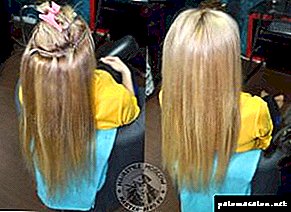
Hair extensions on tressa is the most sought-after direction of the design art in modern times.
False hair is used to change the silhouette of the hair: creating additional length and volume.
The fashion for “fake hair” first appeared in the Baroque era, influenced by the French royal court: all of Europe began to wear wigs.
At the end of the XIX century, new trends in the use of laundry products emerged, chignons, bunches, patch bangs and individual curls came into vogue.
In the middle of the last century, wigs and hairpieces were also very popular among women who want to look fashionable.
At present, the technology of hair cracking has gained popularity, which consists in creating the finished product (tress) by fastening individual strands with the help of threads or polymer tape.
Extension technologies
Tress can be made from artificial or natural strands. Finished products are sold in specialized stores, the price depends on the length and origin of the hair: Slavic, European, oriental.
If the tresses are made of natural hair, the length can vary from 10 to 75 cm.
Slavic hair is in greatest demand because it is soft and supple, blends harmoniously with any hairstyle.
Artificial tress can be of different lengths, thicknesses and have a different shape of curls and color. The cost of products from non-natural hair is incomparably less.
There are various technologies of hair extensions, but, in fact, they differ only in the method of fixation.
The choice of method depends on the purpose of extension, the shape of the hairstyle, the length of the hair and other criteria.
Many women, as evidenced by reviews, prefer to attach tresses to give the hairstyle of the original form only for solemn occasions.
However, there is a significant part of the fair sex, who believe that tress should beautify the appearance daily. Therefore, the method of fixation may vary significantly.
For example, the popular method of “putting on” allows you to wear tresses all the time. It consists in weaving several rows of horizontal braids and sewing on them the basis of interconnected overhead strands.
This method of fixing can only be implemented using the wizard. However, the extension correction can be carried out after two months.
Reviews of women say that this method of fixing almost does not deform their own hair, and the hair looks natural (as evidenced by numerous photos).
There are hot and cold technologies of building. The first involves the use of special resins and adhesives for fixing, as well as the use of thermal pistols or other devices for thermal exposure.
Recently, the leading position occupied by methods of cold building, as they bring minimal harm to natural hair.
Popular method of mounting tress with special hairpins. It can be implemented by women independently at home.
Fixing at home
Correctly attach tresses without the help of a hairdresser can be easily learned through master classes presented on video.
In general, the process is not complicated, but to achieve a positive result, you should heed the advice of women.
Women who have significant experience in building, recommend to adhere to the following rules:
- Hair can look natural and volumetric, if the tresses are arranged in several tiers,
- It is necessary to start fixing the strands from the bottom of the neck,
- The size of the base of the lower tress should be larger than in the higher tiers,
- It is desirable that the ends of the tress are not close to the temples,
- For reliable fixation of the strands at the roots of the hair, you can do a small bouffant
- An additional effect is created by strands fixed in the temporal part.
Reviews of women say that the attachment zones of tress are less noticeable if the hairstyle has wavy curls, and the presented photos and videos reflect the validity of such statements.
Professional approaches to building
You can purchase tresses in specialized stores or arrange an order for individual production by the masters of the designer.
The choice is desirable to make on the basis of professional advice, since the strands must match the type of hair and shape of hair.
Ready-made products manufactured in the factory can have the same length of all the strands.
In the future, natural curly hair can be subjected to any treatment using styling products, it is possible to use pleyos, irons and other devices.
Tresses should be periodically washed with a shampoo, in fact, care for them does not differ from the methods used for natural hair.
It is better to carry out hair extensions on tresses for the purpose of daily use in specialized salons.
Professional methods allow you to securely lock the strands and make invisible attachment zones.
In addition, there is no need to use special clips that create discomfort during prolonged wear. Hairdresser carries out the process of building in several stages.
Prepares the client's hair to create the desired hairstyle, which will include hair products.
Pre-staining can be done or perm, change the overall silhouette of the hair.
Fixed tress using the selected technology. In the present, stitching with special threads to preformed French braids is most popular.
Hair extension on tresses is undoubtedly one of the most effective ways to create original and fashionable hairstyles.
However, the fixation technology, even the most benign, does not contribute to the health of the hair in general, therefore, experts recommend taking breaks in the use of detergents.
3810 November 20, 2015
Tress hair extensions - what is it?
This technique consists in sewing special tresses to their native curls. These are overhead strands, which can be of different lengths (from a few centimeters to 1 meter). Thus, you can increase the hair even to the waist.
This method of building has one feature - tresses can be easily removed at any time. Therefore, this technology is especially recommended for girls who have never done a buildup and want to experiment with their appearance.
Even if you don’t like the result, you can easily and quickly remove overhead strands at home without resorting to the wizard’s services.
Tress builds on a certain technology that requires knowledge and skills. Therefore, such work should be entrusted to an experienced master.Otherwise, to achieve the desired result will be almost impossible.
Sewing on tressov is relatively inexpensive. You can purchase a set of such strands by yourself.
But it is better to first consult with a wizard who will help you choose the most suitable option for your curls.
Tress are reusable. This provides financial savings, since with each subsequent correction you will not have to purchase a new set.
Tressa hair extension technology
Hair extension sewing tress is performed by a certain method. First, all the strands are carefully combed and divided into sections. Then the master braids tight braids at each site.
Attached to them donor curls. It can be bunches of artificial or natural hair. For sewing use thin threads. As a result, the attached curls are hidden under the upper strands.
Due to this, the attachment points remain invisible.
Sewn beams create additional volume, but at the same time provide a natural look of hair. At the end, the master corrects the shape of her hair by cutting off the tips. The whole procedure takes no more than two hours. The exact time depends on the selected length and thickness of your curls.
It is worth considering that a correction will be required as the roots grow. Perform this procedure is necessary in the cabin. In order to maintain a neat appearance of the hairstyle, experts advise making an adjustment as soon as the curls have grown 1 cm. Correction consists in interweaving tresses.
Care for hair after building
If used for sewing high-quality natural hair, especially complex care is not required. Overhead strands on tresses can not be rubbed strongly with a towel.
They should be carefully combed using a special comb. Do not twist wet overhead locks with a towel. Try not to use devices that suggest exposure to too high temperatures.
Avoid the use of thermal rollers, powerful hair dryer and curling.
Periodically make restoring and strengthening masks, apply nourishing balms on strands. Removable lining comb each time after removal. Otherwise, the strands will be tangled, and the hairstyle will lose an attractive neat appearance. In order to prevent the formation of tangles in the upper part of the lining, as well as along the whole length of the strands, regularly comb your hair with a special comb.
Reviews after hair extensions on tresses
Find out what other women think about this procedure. How safe and effective it is, how long the overhead strands last after the tress hair extensions have been done — the girls' calls will help you decide in favor of this extension technique.
Ways to hair extensions - which one is better
Pros and cons of hair extensions
What is the safest hair extensions
Is hair extension harmful and why?
African American Hair Extension Technology

In the African-American technology of hair extensions on the back of the head, a very thin micro-braid called a braid is woven from ear to ear and tresses (chignon-type products in the form of a thin strip of hair) of the desired length, color and appropriate structure are sewn to it in a certain way. It can be natural hair or artificial. Thus, you can make as three rows, and the whole head! African Americans have a widely used method.
Sewing on tress refers to the “environmentally friendly” method, is not “afraid” of high temperatures, dyeing, with natural hair tress can be used an infinite number of times! Wearing time as hair regrowth: 2-3 months.
Afronarasshivanie hair allows you to give your hair the desired volume and length without the risk of injuring natural curls.
This technology is one of the most benign, since absolutely no auxiliary tools and materials — resin, glue, and forceps — are needed for building.
All that is needed is skillful hands of the master and high-quality donor strands. Prices for afaroschivanie relatively low, and the result looks very natural.
Hair extension
Correction is recommended every 2-3 months. The hair grows, as a result, the pigtails fall down, and the attachment points for tress and natural curls become noticeable. Focus on your hair growth, but as soon as you feel that the weaving has weakened, rush to the master.
In order to remove overhead strands, in afaring, unlike many other methods, no special tools and solutions are used. The master unravels the braids and weaves them higher, and then re-sews the donor strands.
Tress not deteriorate during operation, they can be used an infinite number of times.
Pros afronaschivaniya hair
- This type of hair extension is almost harmless, but requires correction every 3 weeks.
- Hair is not exposed to chemicals, thermo-devices, adhesives, all kinds of forceps and clamps,
- Afronaraschivanie suitable for any color and type of hair,
- Overhead strands are not combed out.
- Tress sewn during the first build can be used repeatedly,
- The procedure itself takes less time compared to many other, more complex methods of extension,
- In the work of the master uses only environmentally friendly materials
- You can use any masks and balms, dye, curl, tint hair extensions, go to the sauna, solarium, without fear that the tress will slip,
- Overhead curls can be removed independently, but it is better, of course, to contact the master,
- Hair extensions on braids will suit even those girls who suffer from allergies and cannot, say, increase their hair using capsule technology.
Cons afronaschivaniya hair
- When washing your hair is dry for a long time, it is difficult to do with short and too thin hair. The original length of your own hair should be at least 20 cm, that is, sufficient to weave a pigtail. In addition, unlike other methods, this does not provide an increase in the total volume of the hair - only the desired length.
- We'll have to give up high hairstyles, as weaving will be noticeable,
- In places of attachment tress hair is difficult to comb, you need to do it very carefully,
- The faster the hair grows, the more often it will be necessary to make a correction.
- This hair extension technology is not suitable for short haircuts.
Contraindications
Tress hair extensions are contraindicated in:
- chemo, - antibiotic, - hormone therapy,
- high blood pressure
- hypersensitive scalp,
- strong hair loss.
Building techniques
Hair extension tress divided into several types:
- afronaschivanie hair (it is Hollywood and French). Curls sewn on pigtails,
- Japanese - strands are sewn on the prepared rings,
- bonding - building with a special glue.
Afroharing
The procedure for building capacity:
- Carefully washed and dried strands on the head are collected in a bun and fastened with a hairpin. The area on the back of the head, which will be used in the work of the first, remains.
- The master weaves a special French braid horizontally. It is worth making sure that it was tight, located close to the roots, but did not cause discomfort to its owner.
- How to fix tressy. After the braid is ready, with the help of a needle and thread, the master applies an artificial strand to it. Then stitches connect the braid and the tress itself.
- Further African hair extensions occur on the same principle. In this case, the rule is observed: one tress - one pigtail.
- After all the strands are attached (the master does not touch the top of the head), the hair is corrected: styling, haircut.
Similar to hair extensions on a pigtail, only here, instead of a braid, rings are used:
- Washed and dried curls are divided into areas: the back of the head, temples, marginal zones. In this form, they are collected in bunches and fastened with a barrette.
- Starting from the neck, the master takes a thin strand of native hairs and a thread of about 30 cm, which covers the resulting mini-tuft.
- The ends of the thread are threaded into a special ring and tensioned so that the strand extends into the ring and to the very roots.
- The ring is clamped with forceps closer to the scalp.
- By the same principle, other strands are formed in a row at a distance of 1 cm from each other.
- As soon as the required number of rings is reached (about 9–11 pieces of the lower row), tress is sewn to them.
- The next row is created at a distance of 4–5 cm from the previous one.
Unlike other methods, glue is present here. The work takes place in several steps:
- The hairy part of the head is divided into horizontal zones. The first is approximately at a distance slightly higher than the earlobes.
- Glue is applied on tress at the junction of hairs.
- The prepared strand is pressed against the first (occipital) zone for a few seconds.
- Thus, all zones are glued.
Consider the correction methods depending on the method of building:
Afroharing
If this is African hair extensions, then you need to fix your hair about once every three months. A long period of wear is due to the fact that the build-up on the pigtail is held close to the roots, therefore, when natural strands grow, the junction remains invisible for a long time.
The correction is similar to the African hair extension itself and goes through several stages:
- The master detaches the artificial strands from the braid, and unwinds the braid itself.
- Further, the head must be washed and dried.
- The next stage is weaving new braids. The main thing - do not braid "spike" in the old place. Otherwise, it may lead to the weakening and fragility of native curls.
- Tresses used in the previous building are sewn to the weaving sites.
Like the hair extension, the Japanese wear up to three months. The term depends on the individual growth of natural strands. As soon as the tress drops a couple of centimeters, it's time for the master.
The procedure consists of the following steps:
- Tress is separated from the rings.
- The rings themselves are opened and new strands are formed with new rings.
- Next, a previously disconnected tress is sewn.
Glued strands quickly become noticeable, therefore it is worth resorting to correction at least 1–1.5 months.
Stages of the procedure:
- A special deactivator is applied to the attachment points.
- Artificial strands are disconnected, native - washed, dried and well combed.
- Further retranslation is carried out.
Before and after pictures
Care after the procedure
When using African or Japanese hair extensions, the treatment remains the same. One rule - native hair combed separately from the sewn. Everything other procedures can be done: dyeing, laying, curling and so on.
Advantages and disadvantages of the procedures
African hair extensions, like Japanese tressovogo, has many advantages.
Pros:
- afronaschivanie hair and Japanese - a method without chemical and thermal effects, and therefore does not cause harm to the native hair,
- care remains the same as it was before the procedure
- long lasting result
- Suitable for all hair types,
- you can use false strands many times
- the procedure is performed quickly (0.5–2 hours),
- removal can be done independently (if it is African hair extensions),
- price,
- possibility to increase the hair style by 3 volumes. Other techniques do not give such a result.
Disadvantages:
- in the first days there is discomfort,
- need special combing,
- not suitable for short haircuts less than 20 cm long,
- You can not do high hair,
- untimely correction can lead to the formation of tangles in places braided "spikelets" and they will have to be cut off,
- need to protect from entanglement. When the wind is better to braid braid or hide the hair under a hat. At night, too, braid a dead pigtail.
Bonding advantages:
- can be done at home,
- quick procedure - up to 2 hours
- can be laid and curled without touching the glued area,
- accrued strands are not combed out.
Minuses:
- you can not paint and go to the bath,
- allergic reactions are possible,
- need frequent correction
- You can not do high hair.
Hair tress choose many of the fair sex. Particularly relevant hair extensions on the pigtail. After all, with its help you can become the owner of a thick and long hair quickly and without harm to native strands.
Useful videos
Hair extension tress.
Training in hair extension tress.
Hair extensions on tresses or home make-up

Hair extensions on tresses or afar hair extensions — this technology has a dual name because of its particular procedure, but more on that later. This technology has received the proud title of ECO-building.
Why IVF ?! Because this procedure is absolutely harmless, chemical agents are not involved in its implementation, and there is also no thermal effect. Hair extensions on tresses are due to the appearance of Negro girls who have always strived for long, straight strands, like those of Europeans. Before the appearance of afaron, the black women had to go through a lot so that their curls were not so tight and curly. Many of these procedures brought great damage to the health of the hair. After several such hairdressing experiments, the Afro-beautys found the ideal solution, called the African buildup. How was the procedure invented ?! To produce hair extensions by sewing on tress, the girls began to braid short braids all over their heads, as well as medium-length French braids, and then with the help of threads and needles they began to sew their own sheared curls on them, and then artificial strands. Tresses are thin strands fastened together by a strip of fabric, the width of such strands depends on the place of attachment. On the back of the head, the tresses are wide, and on the temples are thin, narrow. By the way, it was the detail with braid weaving that gave some people a reason to call the African buildup French. Nowadays, aerial nursing lost a little its former glory. First you need to understand in more detail what tress is. Tress, as noted above, these are overhead strands of different widths of artificial or natural hair, fastened together by special threads and special weaving. They are made either by hand or by machine. Manual manufacture allows hair extension using the tress method to make an order of magnitude better and stronger than factory production. Of course, the price of a hand-made product will be much higher, but the number of combed and broken curls will be less. Tress sold in specialized stores where you yourself can choose the desired length and color of future hair extensions. Typically, tressy are Chinese or Indian-made or European, Slavic. European hair is more popular because it is softer and silky. The cost of a set ranges from 200 to 300 dollars. While the price of other, more rigid is about 80 dollars. Afronarasshivanie hair tressy requires manual dexterity and skill of a professional, as well as a creative approach to their work.We met one of such masters at a symposium on strand extension. Here is what he told us: technologies are changing, they are becoming more perfect, but sometimes the old proven methods remain in their unchanged positions for a long time than new ones. These hardened and proven old men include the hair extension. Perhaps, not soon, such a technique will be developed that could surpass this method by such parameters as:Tressy- safe and gentle means to increase the volume and length
African build-up and its advantages
The advantages of such a hairstyle are noticeable immediately after the procedure: neither tresses nor braids cause inconvenience. Take off you can sleep, comb, go to the bath, pool and swim in the sea. Both your own and accrued strands can be pampered with balsam or oils without fear that the tape strands will disappear.
Afronarashchenny hair can also be dyed, straightened with an iron and blow-dry. Many women even manage to do such high-tech hairstyles, like a bobble or a bun. This is evidenced by the numerous reviews of visitors on the forum sites. Proper installation does not allow an outsider to notice the attachment of strands with pigtails.
Just need a little workout and everything will be okay.
Of course, the rave reviews in favor of hair extensions by the African method say a lot, but are there any disadvantages? Yes.
Afronar hair extensions –minuses and contraindications
- African extensions can be done only on medium hair.
- Such a build cannot afford high styling or a ponytail.
- Quite complex care for the hair.
- The high cost of the procedure hair extensions on tresses.
African build-up and technique of its execution
Hair extensions on tresses - a fairly simple procedure lasting 1.5 - 2 hours. To carry it out at home or in the salon, first of all, the hair strands themselves, a strong thread and a curved needle are needed.
- To begin with, the master divides the head into several horizontal partings, weaves short braids between them, and then with the help of a needle he sews tresses. To give the hair an ordinary thickness will require tress from one volume (100 grams of hair). To make the hair more pomp, you need 2 - 3 volume. The length of the accrued strands depends on its cost and the wishes of the client. The most affordable and popular among young people is 50 - 70 centimeters.
- As soon as you have the necessary amount of tresses sewn, then the next step will be cutting them to the length you need with stacking.
If you did everything right in the salon and you do not threaten any medical contraindications, then you can safely use your African hairstyle for 2.5 - 3 months.
Correction of accumulated tress
When your hair grows back, the pigtail falls lower, and this affects the visibility of the attachment points, they become noticeable to others. This is a signal for correction. Or you felt the weakening of the braids, it also signals the need for correction.
If in the other methods of building up, chemical means and tools were required for removal, then they would not be required in the afar. For correction, it is only necessary to twist the pigtails.
After that, the same curls are re-sewn to the braids. The approximate time for correction is 2–3 months after the procedure of extension.
Everything is natural individually, and depends on the growth rate of your hair.
: procedure afaroschivaniya
Hair extensions on tresses: reviews, video

Hair extensions on tressa is the most sought-after direction of the design art in modern times.
False hair is used to change the silhouette of the hair: creating additional length and volume.
The fashion for “fake hair” first appeared in the Baroque era, influenced by the French royal court: all of Europe began to wear wigs.
At the end of the XIX century, new trends in the use of laundry products emerged, chignons, bunches, patch bangs and individual curls came into vogue.
In the middle of the last century, wigs and hairpieces were also very popular among women who want to look fashionable.
At present, the technology of hair cracking has gained popularity, which consists in creating the finished product (tress) by fastening individual strands with the help of threads or polymer tape.
Extension technologies
Tress can be made from artificial or natural strands. Finished products are sold in specialized stores, the price depends on the length and origin of the hair: Slavic, European, oriental.
If the tresses are made of natural hair, the length can vary from 10 to 75 cm.
Slavic hair is in greatest demand because it is soft and supple, blends harmoniously with any hairstyle.
Artificial tress can be of different lengths, thicknesses and have a different shape of curls and color. The cost of products from non-natural hair is incomparably less.
There are various technologies of hair extensions, but, in fact, they differ only in the method of fixation.
The choice of method depends on the purpose of extension, the shape of the hairstyle, the length of the hair and other criteria.
Many women, as evidenced by reviews, prefer to attach tresses to give the hairstyle of the original form only for solemn occasions.
However, there is a significant part of the fair sex, who believe that tress should beautify the appearance daily. Therefore, the method of fixation may vary significantly.
For example, the popular method of “putting on” allows you to wear tresses all the time. It consists in weaving several rows of horizontal braids and sewing on them the basis of interconnected overhead strands.
This method of fixing can only be implemented using the wizard. However, the extension correction can be carried out after two months.
Reviews of women say that this method of fixing almost does not deform their own hair, and the hair looks natural (as evidenced by numerous photos).
There are hot and cold technologies of building. The first involves the use of special resins and adhesives for fixing, as well as the use of thermal pistols or other devices for thermal exposure.
Recently, the leading position occupied by methods of cold building, as they bring minimal harm to natural hair.
Popular method of mounting tress with special hairpins. It can be implemented by women independently at home.
Fixing at home
Correctly attach tresses without the help of a hairdresser can be easily learned through master classes presented on video.
In general, the process is not complicated, but to achieve a positive result, you should heed the advice of women.
Women who have significant experience in building, recommend to adhere to the following rules:
- Hair can look natural and volumetric, if the tresses are arranged in several tiers,
- It is necessary to start fixing the strands from the bottom of the neck,
- The size of the base of the lower tress should be larger than in the higher tiers,
- It is desirable that the ends of the tress are not close to the temples,
- For reliable fixation of the strands at the roots of the hair, you can do a small bouffant
- An additional effect is created by strands fixed in the temporal part.
Reviews of women say that the attachment zones of tress are less noticeable if the hairstyle has wavy curls, and the presented photos and videos reflect the validity of such statements.
Professional approaches to building
You can purchase tresses in specialized stores or arrange an order for individual production by the masters of the designer.
The choice is desirable to make on the basis of professional advice, since the strands must match the type of hair and shape of hair.
Ready-made products manufactured in the factory can have the same length of all the strands.
In the future, natural curly hair can be subjected to any treatment using styling products, it is possible to use pleyos, irons and other devices.
Tresses should be periodically washed with a shampoo, in fact, care for them does not differ from the methods used for natural hair.
It is better to carry out hair extensions on tresses for the purpose of daily use in specialized salons.
Professional methods allow you to securely lock the strands and make invisible attachment zones.
In addition, there is no need to use special clips that create discomfort during prolonged wear. Hairdresser carries out the process of building in several stages.
Prepares the client's hair to create the desired hairstyle, which will include hair products.
Pre-staining can be done or perm, change the overall silhouette of the hair.
Fixed tress using the selected technology. In the present, stitching with special threads to preformed French braids is most popular.
Hair extension on tresses is undoubtedly one of the most effective ways to create original and fashionable hairstyles.
However, the fixation technology, even the most benign, does not contribute to the health of the hair in general, therefore, experts recommend taking breaks in the use of detergents.
3810 November 20, 2015
Hair extensions on tresses
Looking for a way to quickly create long luxurious curls? Then you will need hair extensions on tresses. Find out what this technology is, what its features are and what effect can be achieved.
Tress hair extensions - what is it?
This technique consists in sewing special tresses to their native curls. These are overhead strands, which can be of different lengths (from a few centimeters to 1 meter). Thus, you can increase the hair even to the waist.
This method of building has one feature - tresses can be easily removed at any time. Therefore, this technology is especially recommended for girls who have never done a buildup and want to experiment with their appearance.
Even if you don’t like the result, you can easily and quickly remove overhead strands at home without resorting to the wizard’s services.
Tress builds on a certain technology that requires knowledge and skills. Therefore, such work should be entrusted to an experienced master. Otherwise, to achieve the desired result will be almost impossible.
Sewing on tressov is relatively inexpensive. You can purchase a set of such strands by yourself.
But it is better to first consult with a wizard who will help you choose the most suitable option for your curls.
Tress are reusable. This provides financial savings, since with each subsequent correction you will not have to purchase a new set.
Advantages and disadvantages of the procedure
Hair extensions on tresses have pros and cons, which are worth finding out before making a decision in favor of this procedure. Of the benefits worth highlighting:
- No need to use forceps, capsules and other devices that can damage the curls.
- No harm to hair.
- Additional volume appears.
- The occurrence of an allergic reaction is excluded.
- Mounts hold for a long time.
- Ability to remove strands independently.
- Tresses are invisible, even when a strong wind blows.
- Attachment points are weather resistant. With such curls you can walk even in the rain, without fear of messing up your hair.
- You can perform all the same cosmetic cosmetic procedures that are applicable to your natural hair.
- The procedure does not take much time. Sew one overlay can be in 10 minutes.
- Low cost in comparison with other techniques.
- Some tressy can be worn for years.
- No need for frequent correction.
As you can see, the advantages of this technology are many. But do not make hasty decisions. First, find out what disadvantages and contraindications this extension has.
If you do not make a timely correction, hair will look sloppy. The places where tresses are sewn are lowered as the roots grow. Strands may go awry. Since this technique involves the weaving of tight braids, after the procedure there may be unusual and not very pleasant sensations. But after two or three days they pass, as they very quickly get used to the tress.
Another problem is that it is not always possible to easily find the right shade. As a result, you have to either paint the entire head of hair with overhead strands, or resort to the services of a professional who can pick up the tresses to match the hair. But even real professionals in their field can not always find the right shade.
If you have weakened damaged curls, there is a slight chance of increased loss and even greater thinning. Therefore, before making this build-up on loose strands, experts recommend taking a course of recovery.
With regard to contraindications, this procedure is not recommended to do with alopecia, as well as owners of thin sparse hair. Otherwise, the tress will look ugly and unnatural.
In addition, it is worth refusing from such an increase for women suffering from hypertension or vegetovascular dystonia of the hypertonic type.
Otherwise, the extension procedure may adversely affect your health due to an increase in curl weight.
Tressa hair extension technology
Hair extension sewing tress is performed by a certain method. First, all the strands are carefully combed and divided into sections. Then the master braids tight braids at each site.
Attached to them donor curls. It can be bunches of artificial or natural hair. For sewing use thin threads. As a result, the attached curls are hidden under the upper strands.
Due to this, the attachment points remain invisible.
Sewn beams create additional volume, but at the same time provide a natural look of hair. At the end, the master corrects the shape of her hair by cutting off the tips. The whole procedure takes no more than two hours. The exact time depends on the selected length and thickness of your curls.
It is worth considering that a correction will be required as the roots grow. Perform this procedure is necessary in the cabin. In order to maintain a neat appearance of the hairstyle, experts advise making an adjustment as soon as the curls have grown 1 cm. Correction consists in interweaving tresses.
Care for hair after building
If used for sewing high-quality natural hair, especially complex care is not required. Overhead strands on tresses can not be rubbed strongly with a towel.
They should be carefully combed using a special comb. Do not twist wet overhead locks with a towel.Try not to use devices that suggest exposure to too high temperatures.
Avoid the use of thermal rollers, powerful hair dryer and curling.
Periodically make restoring and strengthening masks, apply nourishing balms on strands. Removable lining comb each time after removal. Otherwise, the strands will be tangled, and the hairstyle will lose an attractive neat appearance. In order to prevent the formation of tangles in the upper part of the lining, as well as along the whole length of the strands, regularly comb your hair with a special comb.
Photo result after hair extensions tress
See what a hairstyle looks like after sewing tresses. If you use high-quality hair and choose the right shade, you will not distinguish increased beams from your own curls.
Price for hair extensions on tresses
The cost of sewing tress varies in the range from 5 to 10 thousand rubles. The price depends on the quality, quantity and length of the hair, the level of the master and the status of the beauty salon where the service is offered.
Hair extension on tresses - video
So that you can clearly imagine how this type of extension is carried out, we suggest watching this video. It shows in detail each stage of such technology.
Reviews after hair extensions on tresses
Find out what other women think about this procedure. How safe and effective it is, how long the overhead strands last after the tress hair extensions have been done — the girls' calls will help you decide in favor of this extension technique.
Ways to hair extensions - which one is better
Pros and cons of hair extensions
What is the safest hair extensions
Is hair extension harmful and why?
African American Hair Extension Technology

In the African-American technology of hair extensions on the back of the head, a very thin micro-braid called a braid is woven from ear to ear and tresses (chignon-type products in the form of a thin strip of hair) of the desired length, color and appropriate structure are sewn to it in a certain way. It can be natural hair or artificial. Thus, you can make as three rows, and the whole head! African Americans have a widely used method.
Sewing on tress refers to the “environmentally friendly” method, is not “afraid” of high temperatures, dyeing, with natural hair tress can be used an infinite number of times! Wearing time as hair regrowth: 2-3 months.
Afronarasshivanie hair allows you to give your hair the desired volume and length without the risk of injuring natural curls.
This technology is one of the most benign, since absolutely no auxiliary tools and materials — resin, glue, and forceps — are needed for building.
All that is needed is skillful hands of the master and high-quality donor strands. Prices for afaroschivanie relatively low, and the result looks very natural.
Extension technology
Afronaraschivanie (tressov hair extensions or sewing tress) - one of the safest ways to artificially lengthen the curls. He appeared on the hottest continent of our planet.
African girls have naturally tough and curly hair, they grow slowly, and after straightening (which, alas, persists only until the next shampooing) deteriorates and loses its luster. But the black beauties still managed to come up with their own way to make hair straight, long and thick.
Around the head they began to braid pigtails, and attach bundles of artificial hair to them. Today, it looks different, because hairdressers, of course, have perfected the invention of the enterprising peoples of Africa. The master braids thin braids all over the client's head.
With a special needle and thread, he sews ready-made hair tresses, fastened on both sides with a strip of fabric.In this case, the master tries to position the tresses as close as possible to the hair roots. Overhead strands completely cover the braids, so for others they are invisible.
Wide tresses are fastened on the back of the head, narrower at the temples. It is done afro-hair extension for a length of 20 cm or more. It takes 2-3 hours to weave braids and sew tress on them.
Hair extension
Correction is recommended every 2-3 months. The hair grows, as a result, the pigtails fall down, and the attachment points for tress and natural curls become noticeable. Focus on your hair growth, but as soon as you feel that the weaving has weakened, rush to the master.
In order to remove overhead strands, in afaring, unlike many other methods, no special tools and solutions are used. The master unravels the braids and weaves them higher, and then re-sews the donor strands.
Tress not deteriorate during operation, they can be used an infinite number of times.
Pros afronaschivaniya hair
- This type of hair extension is almost harmless, but requires correction every 3 weeks.
- Hair is not exposed to chemicals, thermo-devices, adhesives, all kinds of forceps and clamps,
- Afronaraschivanie suitable for any color and type of hair,
- Overhead strands are not combed out.
- Tress sewn during the first build can be used repeatedly,
- The procedure itself takes less time compared to many other, more complex methods of extension,
- In the work of the master uses only environmentally friendly materials
- You can use any masks and balms, dye, curl, tint hair extensions, go to the sauna, solarium, without fear that the tress will slip,
- Overhead curls can be removed independently, but it is better, of course, to contact the master,
- Hair extensions on braids will suit even those girls who suffer from allergies and cannot, say, increase their hair using capsule technology.
Cons afronaschivaniya hair
- When washing your hair is dry for a long time, it is difficult to do with short and too thin hair. The original length of your own hair should be at least 20 cm, that is, sufficient to weave a pigtail. In addition, unlike other methods, this does not provide an increase in the total volume of the hair - only the desired length.
- We'll have to give up high hairstyles, as weaving will be noticeable,
- In places of attachment tress hair is difficult to comb, you need to do it very carefully,
- The faster the hair grows, the more often it will be necessary to make a correction.
- This hair extension technology is not suitable for short haircuts.
Contraindications
Afronaraschivanie can not be used for excessive hair loss, vegetative-vascular dystonia, diseases of the scalp, cancer, while taking potent medicines.
(1 votes, average: 5,00 5)
Loading ...
Tress hair extension at home

When extending hair by the tress method at home, use strands with special clips. The strand fastener for home extensions is made of silicone.

The use of this light translucent material with non-slip surface allows you to securely lock the strand on your own hair.

As can be seen in the photo, hair extensions on tres using these miniature sized fasteners are almost not noticeable - they are easily hidden in the place of attachment with their own hair.
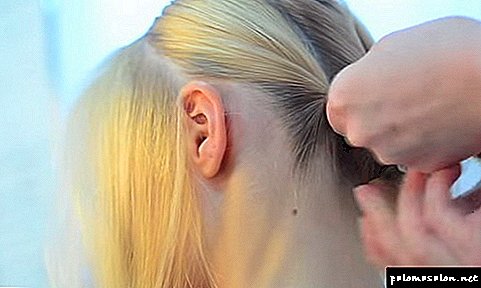

Like any fake hair, the fake strands are made from both synthetic material and natural hair. As the most common material for creating artificial strands, high-quality Japanese Kanekalon is used, which, when weaving the strands into one's own hair, does not differ from them in color, shine and structure.


However, when using strands of Kanekalon, it should be remembered that when wet it becomes very heavy, and since the strands attach to their own hair, this will noticeably increase the tension of the hair and may lead to damage.
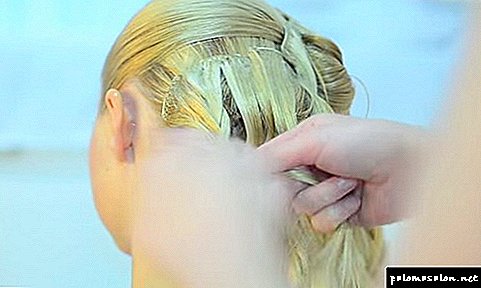
In addition, the strands of artificial material can not be curled (this is done only in the factory), hair extensions can not be dried with a hair dryer, paint.


Thus, synthetic strands significantly limit the ability to change hairstyles, so they are best used for occasional hair extensions, for 1-2 days, for the rest of the time it is better to prefer natural hair, which can be dyed, styled, curled, stretched during use, varying to infinity options for wearing long hairstyles.
Watch a video of hair extensions on tresses to better understand the technology of the process:
Advantages of hair extensions on tresses

The undoubted advantages of hair extensions on tresses are quick and safe for the hair of this procedure compared to salon extensions. Strands can be worn or removed at will, without resorting to the services of hairdressers.
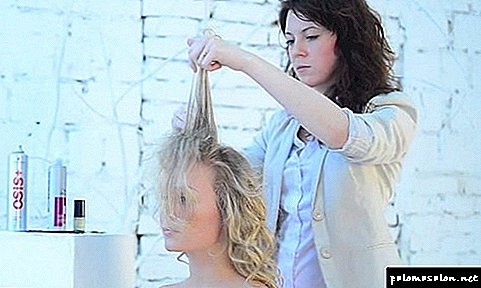
Overhead strands, unlike the salon extension, do not require adjustment, it is enough to remove them and put them back on a new place, with proper care, strands of natural hair can serve for about 3 years.

When purchasing strands for extension, one should not forget that with even haircuts, the length of hair is different in different areas of the head: the hair is much longer at the crown than at the lower part of the back of the head or at the temples.

When purchasing extension kits, these features of growth and length of hair are already taken into account by the manufacturer, and when purchasing individual strands, this nuance should be taken into account independently, otherwise after extension you will have to go to a hairdresser to level the lower edge of your own and extended hair.
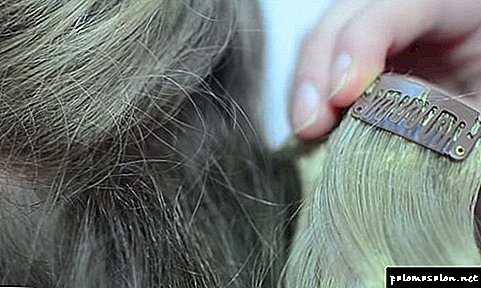
In addition to length, strands in sets differ in width, the widest ones are designed to build up the occipital part, narrow ones - to lengthen the temporal lobes.

The naturalness of the effect obtained when building up depends not only on the quality of the strands used, but also on their quantity: the thinner the strands and the larger their quantity, the more natural the finished hairstyle will look.


The strands are fixed on their own hair, the attachment points are carefully hidden by their own hair.
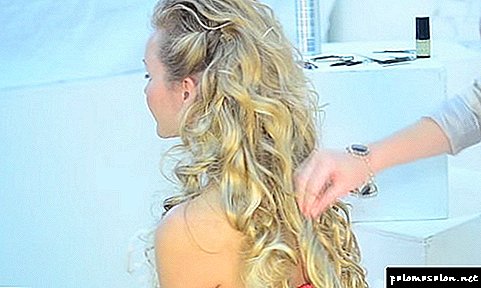
Before fastening, your hair should be lifted upward, leaving only the lowest ones at the back of the head, then fix the short and wide strands for the lower part of the head on them.
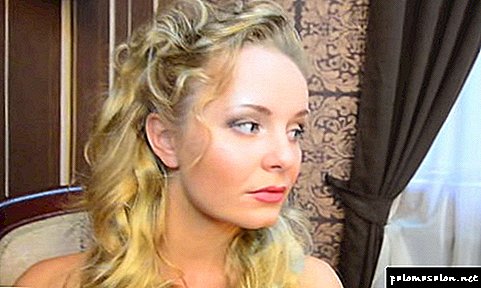
After the lowermost strands are attached, the remaining ones are gradually joined, moving from the hairline to the crown, the latter being fixed on the temples, the attachment lines are carefully closed with the remaining upper own hair.
Disadvantages of building up on tresses

However, this type of extension has its drawbacks: first of all, there is a danger that the fastener will weaken and one or several strands will be torn off the hair, revealing the secret of the luxurious long hairstyle.

The second lack of extension with tresses: no matter how small the clips that attach the strands to the hair, they still have their own weight, and while constantly wearing the strands, they pull the hair down, which is harmful to them.
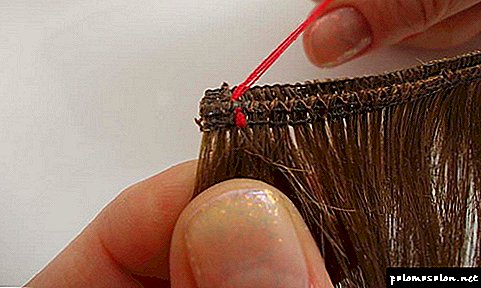
When wearing overhead strands at all times, your own hair can begin to split and break at the attachment points of the clamps.
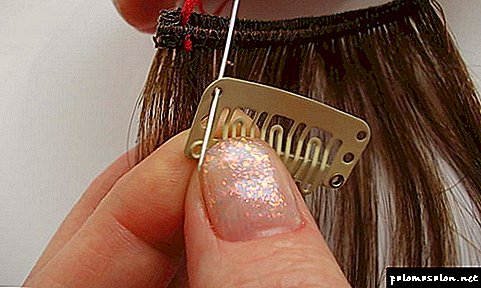
To avoid this, your own hair at the roots before attaching the strands must be combed. In this case, the clip will not slip through the hair and harm it.

Strands, unlike their own hair, do not grow and are not restored, so too frequent dyeing, ironing, and curling will eventually ruin their structure and strands will lose their original appearance and shine, they will have to be changed.
Little tress
A popular device in the world of hair care appeared more than thirty years ago. In the eighties of the last century, when the procedure appeared in beauty salons, tresses were in great demand among celebrities and ordinary women. Year after year, new technologies were invented to increase the efficiency of the process, but modern methods could not force out the time-tested, accustomed to many tress build-up.
The technology is included in the category of cold procedures, because the process does not involve various means adapted for the thermal treatment of curls. Tress resemble chignon, but in a more convenient form, devices can not be removed, wear constantly. Artificial hair is firmly fixed to the natural strands on a strip of thread. Typically, the length of the accreted curls does not exceed seventy centimeters.
Hair extensions on tresses require a certain break between treatments. The minus that can be found in technology is a great kind of artificial strands from real ones from close range. However, the hair is attached very well, accidentally combing a bunch of donor hair is unlikely to succeed.
A high-strength sewing thread is sewn into the devices, and after that, the strand is attached to natural curls. The process of sewing the thread can be carried out by the master in two ways:
- Manually. The specialist in the cabin sews the thread independently, but the manual work usually takes a lot of time.
- Factory method. Here the procedure is performed faster, because a special machine is engaged in sewing the thread for a person.
Variants of the procedure
By the method of attaching the strands to the client's head of hair, the following types of extension are distinguished:
- Removable. Curls are attached by means of metal hairpins. The size of the devices is quite small, so the barrettes are imperceptible, and their weight does not cause discomfort when worn. The fastening method is shown in the photo below.

Both technologies are harmless to the structure of the hair, which does not have to be injured by exposure to thermal agents. The glue used in the process does not cause allergies in the clients, like sewing threads.
Removing the false curls is very simple: just dissolve the threads attached to the hair. In the case of barrettes, it is necessary to remove the small fixtures that secure the strands. Reviews of technology have repeatedly confirmed the safety and effectiveness of the method of increasing the length of hair.

Fixed equipment
The procedure performed in the salons, is quite simple and clear to everyone. To implement the build-up the master weaves the client a narrow little pigtail, which is necessary for work in the future. The number of "spikes" depends on the desired volume and density of curls, usually just two or three braids are enough.
Increasing the length of the strands by sewing is done by means of a sailing needle, the most convenient device among the possible. The master needs to attach the artificial strand to the natural one, and the needle here will well help pierce the pigtail and sew the donor hair. Weaving a pigtail qualitatively is just as important as correctly performing the procedure. From the accuracy of the "spike" depends on the further result and naturalness in the sock. Therefore, a pigtail is a very important element when a tressive increase in the length of curls is performed.
Care for tress
Any hair requires care, including overhead. To care for tress is quite simple.In most cases, processes similar to the usual procedures for natural hair are required. Removable devices must be washed separately from the native strands.
Washing takes place once a month, but, often using hairspray, it is advisable to increase the number of water treatments to once a week or two. Washing should be carried out strictly at specified intervals, as water has a strong influence on the state of artificial strands. Hair extensions on tresses require a more careful attitude to curls.
However, the sewing technology does not allow to remove the strands before washing, so you have to expose the hair to water procedures every time you wash your native hair. It is better to dry the hair naturally, without exposure to a hair dryer.
Hair should be combed carefully using a comb. It is important to walk several times along the whole strand, paying special attention to the upper part: hair is often confused here.
Numerous reviews talk about ease of care for tresses, so you don’t need to worry that you have to spend a lot of time and money on the procedures for patch curls. Everything is quite simple and affordable. In the care, you can use regular shampoos, not necessarily buy professional. The results of the procedure can be seen in the photos below of the girls who have tried the technology.
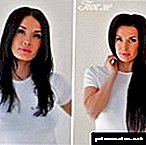
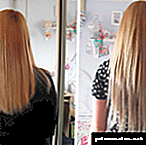


The method has certain disadvantages. The hair roots are significantly weakened, and after long wearing of tresses, problems may arise with the loss of natural strands. However, a professional can get rid of subsequent unpleasant moments by slightly moving the pigtail. Wearing tress for a long time will not work. Reviews mention the need for a monthly correction. This is due to the occurrence of unpleasant sensations in the area where the braid is woven.
But even the cons can not stop the millions of girls going to the salon procedure. Hair extensions on tresses have much more advantages and advantages over other types of technologies.
Tape hair extensions
There is a cold method - tape hair extensions and hot, fixation which occurs with the help of heat.
The big minus of the latter method is that the connecting capsules can be easily combed out with a comb and cannot be restored. What can be said about the tape extension method.

This option is not only convenient, but also safe, since new German technologies are used. Strands are fixed using a thin polymer ribbon, which is 1 or 3 mm from the roots, is distributed evenly on all surfaces of the hair, and does not create any tension in the area of the bulb.
Since the capsules can be reused, one set is enough for one year, with periodic corrections of two or one and a half months. A correction is to transfer donor hair closer to the roots, as they tend to grow.

How to remove hair grown in a tape way?
When there is a desire to get rid of the artificial mane, it is enough just to remove the polymer material in the cabin with the help of a special alcoholic agent, the same is done with the correction - the tape is simply transported upwards.
From this it follows that this type of extension has several advantages at once. First, the fastest method is performed within two hours. Secondly, safety and lack of contraindications for almost all members of the weaker sex.
And, thirdly, natural hair rather quickly and imperceptibly get used to the donor strands, which are imperceptible from the first day and invisible to others. This unique technology of building up the creation of various images is suitable for performance in any environment and has no analogues all over the world.
How to make tape hair extensions: video lesson
Hair extensions on tresses (with photo and video)
Hair extensions on tresses - one of the ways to lengthen the hair. Sometimes in salons hair extension by the method of tress is called aproning. Sometimes the tres are made by hand, then they turn out thin, as close as possible to natural hair. But more often, machine-made strands are used for hair extensions by sewing on tresses.
In any case, the extension on tresses is used quite often, so before you lengthen the hair, you need to familiarize yourself with the description of this procedure.
Lining allows you to slightly extend the bangs or the length of your own hair, but to solve the problem of significant extension, when you need to make strands below the shoulder blades from a short hairstyle or shoulder-length hair, none of the types of the above-described linings are suitable. Building up can be done both at home and in the cabin.
In both cases, special long strands, so-called tresses, are used to increase the length of hair, but salon extension differs from home fixing, which affects the final appearance of the hairstyle and the duration of the result.
Both types of hair extensions have both strengths and weaknesses, so everyone chooses the type of extension that is best suited in this situation.
Hot build
The basis of this type are Italian roots. The technology is called EURO CO SAP. And is perhaps the most harmless procedure for building up. Here the master uses already prepared strands of natural hair, which are attached with keratin and special thermal tongs. Creatine is a type of resin made from natural ingredients. In order to connect the extensible strand with your hair, the master heats it, puts it in the right place and connects it with forceps.
Lasts hot build about four hours. After him, you will be able to amaze everyone around you with your flawless hairstyle for three to five months. At the end of time, hair extensions are removed without any problems for your own curls. If you want to increase the hair again, you will need to contact the master, who will either make the correction or perform the procedure again.
Cold build
The best-known cold-type technique is to build on metal clips. This technology came to us from Japan. For the procedure, both natural and artificial hair strands can be used, which, if necessary, can be used again. The disadvantage of this type of extension is that it is strictly prohibited for people with brittle and thin hair.
The procedure is performed using special clips made of copper or aluminum. With their help strands attached to the hair. Cold build-up lasts three to five hours. It all depends on the length of your hair and the number of accrued strands. After about four months, it will be necessary to make a correction or remove the clips - unclench them with the help of special forceps and pull off the hair.
Care for any type of hair extensions
- You now need to wash your hair just standing under the shower.
- It is not recommended to carry the hair forward while tilting the head.
- Wiping your head, do not overdo it - just gently blot them with a towel.
- Hair care products should be applied along the entire length, avoiding the roots.
- Choose products that do not contain wax and oil additives.
- When playing sports or during sleep, it is best to braid your hair in a braid or tie a tail.
- For combing you can use a regular hair brush.
Hair extensions are the best way not only to change the appearance, but also to gain self-confidence, and, as a result, a good mood. And let many say that the main thing is inner beauty. External to you, too, does not hurt, is not it?

